CIUDAD DEL VATICANO (CNS) – El Papa León XIV pidió a los católicos que recen el rosario todos los días de octubre por la paz.
El Papa hizo esta petición al final de su audiencia general del 24 de septiembre, un día después de haber hablado de nuevo con el párroco de la Iglesia de la Sagrada Familia en la ciudad de Gaza, la única parroquia católica de rito latino en Gaza.
“Gracias a Dios, todos en la parroquia están bien, aunque cada vez las incursiones se acercan más”, dijo el Papa a los periodistas en Castel Gandolfo el 23 de septiembre, antes de regresar al Vaticano tras un día de descanso. La parroquia está ofreciendo refugio y asistencia a cientos de residentes de Gaza.
El Reino Unido, Canadá y Australia reconocieron oficialmente la condición de Estado palestino el 21 de septiembre, sumándose a la Santa Sede y a más de 150 países que ya lo habían hecho. Cuando se le preguntó si eso podría ayudar a la situación, el Papa León respondió a los periodistas que “podría ayudar, pero en este momento realmente no hay voluntad de escuchar al otro bando, entonces el diálogo está roto”.
Respecto a los continuos ataques de Rusia contra Ucrania, el Papa León afirmó que “alguien busca una escalada. Cada vez es más peligroso”.
Lo que se necesita, afirmó, es “frenar los avances militares” y sentarse a la mesa de diálogo.
Al finalizar su audiencia del 24 de septiembre, el Papa León señaló que octubre se acercaba y que, con la festividad de Nuestra Señora del Rosario, el 7 de octubre, la Iglesia Católica tradicionalmente dedica todo el mes al rezo del rosario.
“Invito a todos, cada día del próximo mes, a rezar el Rosario por la paz, personalmente, en familia y en comunidad”, dijo.
El Papa también invitó a los funcionarios y empleados del Vaticano a rezar el rosario juntos cada noche de octubre a las 7 p.m. en la Basílica de San Pedro.
Invitó a todos a la Plaza de San Pedro el 11 de octubre para rezar juntos el rosario durante la vigilia del Jubileo de la Espiritualidad Mariana, recordando también el aniversario de la apertura del Concilio Vaticano II, que comenzó el 11 de octubre de 1962.
Author Archives: Mississippi Catholic
CSA feature: Intercultural Ministry
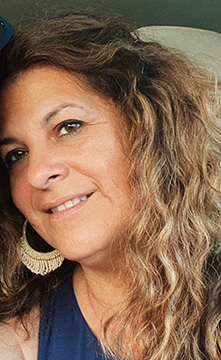
At the Cathedral of Saint Peter the Apostle, parishioner Angelica Mazy has found a calling that has both deepened her own faith and helped others discover the beauty of the church. Through her work in Intercultural Ministry, Angelica is working to become a bridge between people of different backgrounds, fostering understanding and unity within the parish community.
Her journey began during a moment of prayer and reflection. “Recently, I attended the reflection of Pilgrims of Hope,” Angelica recalls. “Some people from the group I belong to also participated, and it was there I felt called to say ‘yes’ to this ministry.”
That simple yes soon became a transformative experience. “Intercultural Ministry is helping me appreciate other cultures and understand other people,” she explains. “We can be bridges in relationships.”
Over time, Angelica has witnessed remarkable changes in others. “There have been several moments in which I’ve seen people grow,” she says. “Some who rarely attended Mass and had not received all their sacraments are living their faith and attending Mass every Sunday. Watching that transformation fills me with hope.”
Stories like Angelica’s reveal the profound impact that parish ministries can have on individuals and communities alike. They remind us that when people come together in faith, lives are renewed, hope is restored, and the church is strengthened.
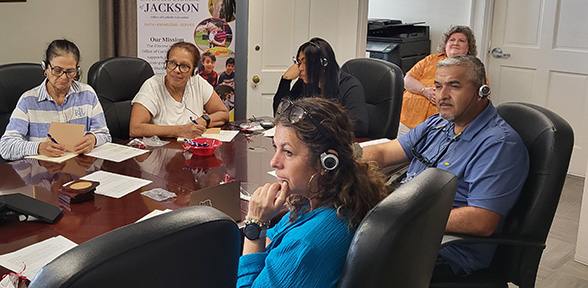
The Catholic Service Appeal makes this possible. Each gift becomes part of the church’s mission to share Christ’s love across cultures and generations. As Angelica beautifully puts it, “All those who help with donations are also evangelizing with their contributions.”
By supporting the Catholic Service Appeal, you share in this mission – helping build bridges of faith, fostering unity, and opening hearts to the transforming grace of God.
The annual Catholic Service Appeal unites Catholics across the Diocese of Jackson to support 14 vital ministries that serve local communities. From faith formation and youth ministry to seminarian education and clergy healthcare, these initiatives help carry the Gospel’s message to those in need throughout the diocese. Give today to help these ministries thrive.
Click here to DONATE to the CSA in support of faith formation
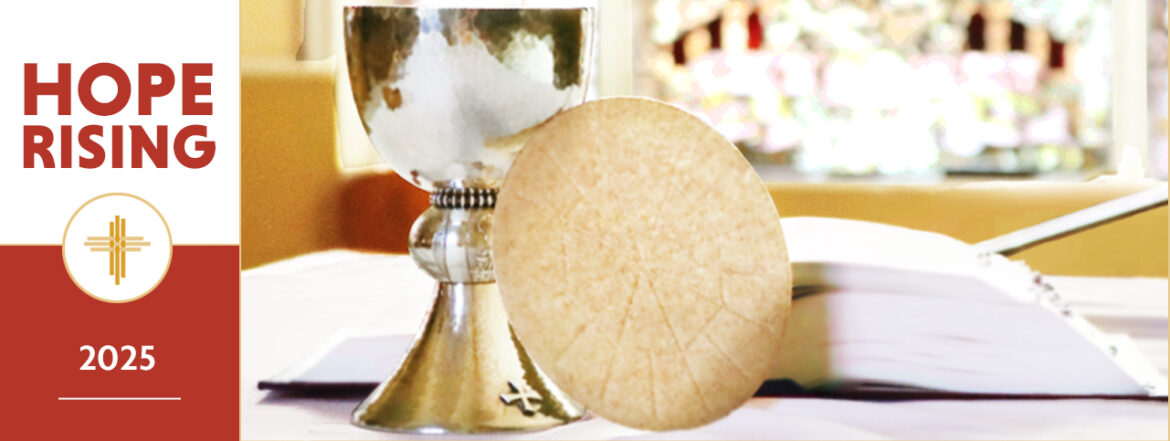
‘Christ calls us to be Christ for one another,’ Mobile’s new shepherd tells faithful
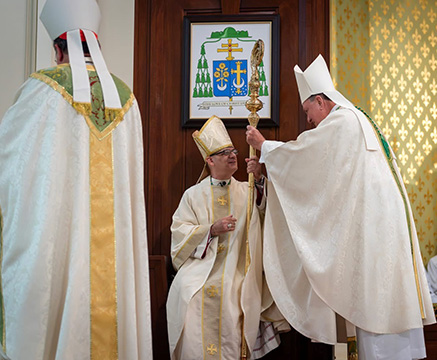
Editor’s note: Bishop Joseph Kopacz and Chancellor Mary Woodward were in attendance at the installation of Archbishop Mark S. Rivituso. From the archives will return in our next edition.
By Rob Herbst/The Catholic Week
MOBILE, Ala. (OSV News) – About 45 years later, the trade between the Archdiocese of St. Louis and Archdiocese of Mobile is complete.
Archbishop Mark S. Rivituso, a former auxiliary bishop of St. Louis, was installed as the third archbishop of Mobile Sept. 3 at the Cathedral-Basilica of the Immaculate Conception.
Archbishop Rivituso, 63, was ordained a priest of the Archdiocese of St. Louis by Archbishop John L. May, who previously served as bishop of Mobile.
While Archbishop Rivituso expressed gratitude for his new assignment on the Gulf Coast, he learned from Archbishop May’s tenure to pray for good weather.
“I don’t know if it’s fact, fiction or embellishment … but it was told to me during (Archbishop May’s) time in Mobile that the area suffered the devastation of a hurricane. Immediately after that, John L. May was appointed to the Archdiocese of St. Louis. The saying goes, ‘One hurricane and you’re gone,” Archbishop Rivituso joked at the closing of Mass.
Archbishop May was appointed as archbishop of St. Louis in January 1980, four months after Hurricane Frederic hit Mobile.
However, weather was no issue on this September sun-soaked day. About 700 people filled the cathedral for Mass, including Cardinal Christophe Pierre, papal nuncio to the United States, along with about 25 visiting bishops and archbishops. Those in attendance included Archbishop Mitchell T. Rozanski of St. Louis, Archbishop Gregory M. Aymond of New Orleans as well as Archbishop W. Shawn McKnight of Kansas City, Kansas, and Archbishop Edward J. Weisenburger of Detroit, who were both installed archbishops earlier this year.
Those unable to sit in the cathedral watched the Mass via livestream at the nearby Saenger Theatre in downtown Mobile.
Archbishop Rivituso succeeds Archbishop Thomas J. Rodi, who served the Archdiocese of Mobile for 17 years. Archbishop Rivituso is the 10th bishop of Mobile and third archbishop of Mobile, dating back to 1829.
While Archbishop Rivituso was installed to lead the Archdiocese of Mobile, he expressed his desire for the faithful to work alongside him in sharing the love of Jesus to all in the southern half of Alabama.
“I am installed as shepherd of the church in the Archdiocese of Mobile, but I acknowledge humbly my need for the faithful to be one with Jesus, be one with me as we show the shepherding love and care of Christ to all in this local church,” Archbishop Rivituso said during his homily.
Cardinal Pierre – a proud Frenchman – opened the Mass and Archbishop Rodi then spoke briefly about the history of Mobile, which was the first permanent French colonial settlement in the U.S.
But before publicly reading the papal bull in which Pope Leo XIV appointed Archbishop Rivituso, Cardinal Pierre deadpanned with a finger wag: “Rivituso … he’s not French.”
However, he added, “Congratulations on the blessing you have received from the Providence of God and by the choice of Pope Leo to become the archbishop of Mobile. May your service to the people here … be a continuing sign of the hope with which God blesses us.”
Upon accepting the apostolic mandate, Archbishop Rivituso presented it to the archdiocese’s college of consultors and walked through the cathedral’s three aisles to show the congregation.
After displaying the papal bull, Cardinal Pierre and Archbishop Rodi escorted Archbishop Rivituso to the cathedra. Archbishop Rodi handed the new archbishop his crosier. Archbishop Rivituso then greeted various archdiocesan dignitaries before the Mass proceeded.
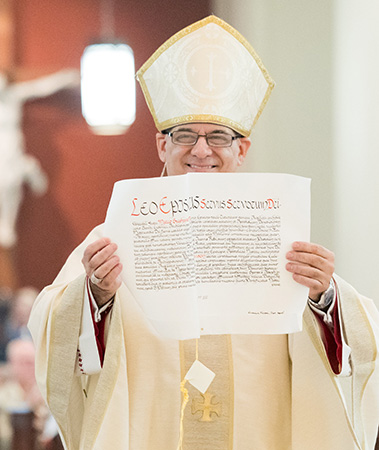
The Gospel reading chosen was Luke 22:24-30 in which Jesus says, “I am among you as the one who serves” and Archbishop Rivituso stressed in his homily the need to serve all.
“We are brothers and sisters and Christ calls us to be Christ for one another,” Archbishop Rivituso said.
“I am excited to be your shepherd,” he said, “working alongside you as we show forth Christ’s shepherding care and love for all – and being especially mindful to reach out with Christ’s shepherding love and care to the poor and the homeless; to reach out with Christ’s shepherding care to our immigrant brothers and sisters in their own fears and anxieties; to be with all those who are imprisoned and on death row and show the comfort of the Lord and show a redemption in the Lord.”
He added, “With the rich history in this archdiocese of civil rights, (I am excited) to build upon the witness of those who advanced civil rights by fostering racial harmony and to be a shepherding, caring church of Jesus. (I look forward to being) present to those who feel forsaken, those who feel forgotten, those who are marginalized, those who are on the peripheries of society.”
Archbishop Rivituso also acknowledged that while many are suffering today, the faithful must remember the words from the Mass’s second reading, 2 Corinthians 4:1-2, 5-7.
“We live in very challenging times. I know many feel disconnected from one another. It is good to hear the word of God through St. Paul today – ‘We are not discouraged.’ We are ministers of hope.”
(Rob Herbst is editor of The Catholic Week, the news outlet of the Archdiocese of Mobile.)
Youth
Faith, Learning and Joy

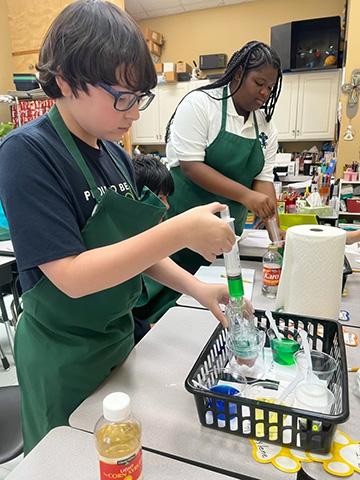
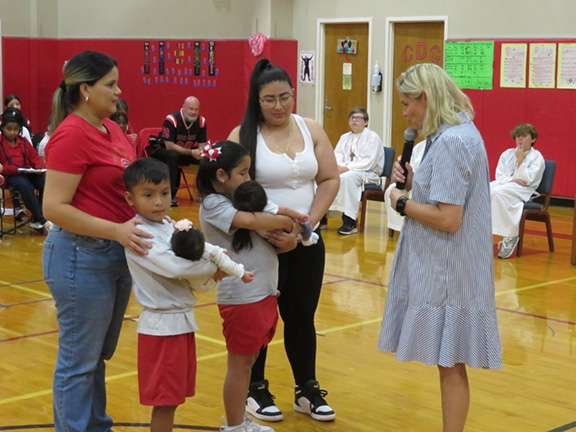
MERIDIAN – (Above) From left, St. Patrick School seventh graders Brandon Franklin, Juan Garcia and Brooklyn McCurty experiment with density towers during science class. (Photo by Glenda Rives)
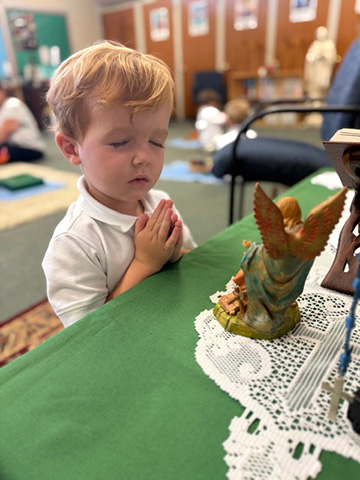
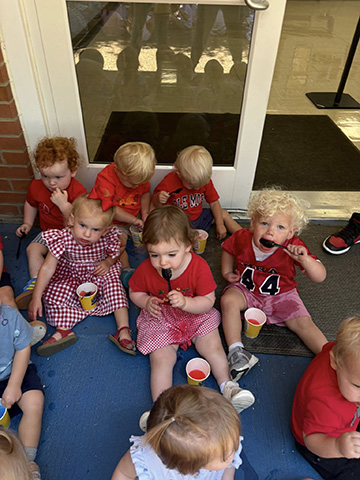
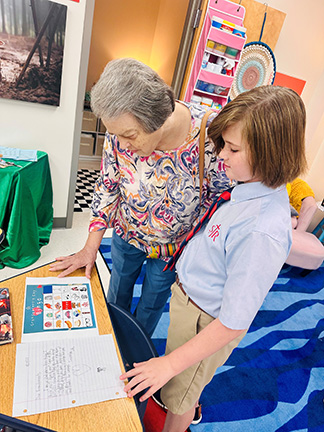
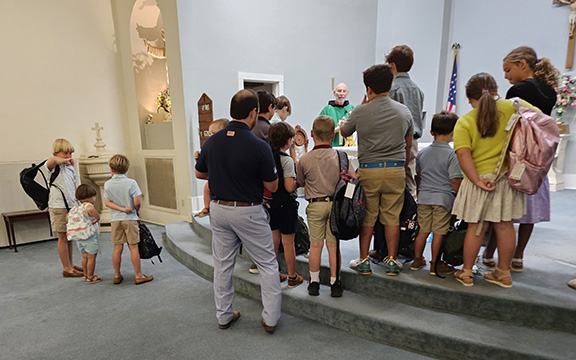
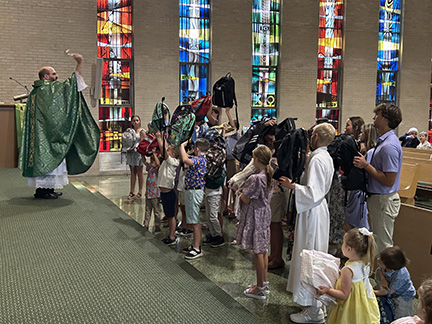
VICKSBURG – Father Rusty Vincent of St. Paul Parish blesses students’ backpacks on Sunday, Aug. 10. (Photo by Allyson Johnston)
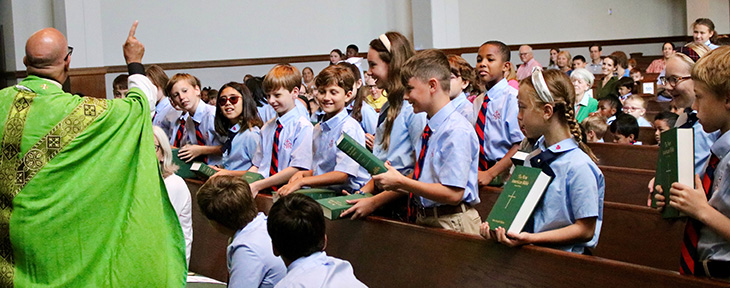
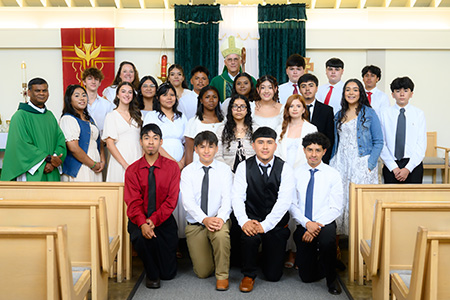
NEW ALBANY – Bishop Joseph Kopacz celebrated the sacrament of confirmation at St. Francis of Assisi Parish on Sunday, Aug. 17, 2025. Pictured with Bishop Kopacz are Father Jesuraja “Raj” Xavier and confirmation students. Top row, from left: Mason Hall (Corinth), Amy Cunningham, Maria Palomeque (Corinth), Diego Moreno, Bishop Kopacz, Valeria Vera, Anthony Chambers, Alex Chambers and Roberto David Loredo Valdez (Corinth). Middle row, from left: Father Xavier, Sonia Rojas, Mina Hall (Corinth), Karen Ortega Antonio, Emily Romero, Isabella Kimmons, Joely Moreno, Ashley Flores, Samantha Navarro, Jesus Gonzalez, Rubi Reveles and Ivan Guzman. Front row, from left: Marcos Rojas, Luis Lopez, Luis Angel Guerrero and Alan Romero. (Photo by Joanna Manning)
Hope is knowing that God is near and that love will win, pope says
By Cindy Wooden
VATICAN CITY (CNS) – Christian hope is not about avoiding pain and suffering but about knowing that God gives people the strength to persevere and to love even when things go wrong, Pope Leo XIV said.
When Jesus allowed himself to be arrested in the Garden of Gethsemane, he showed that “Christian hope is not evasion, but decision,” the pope told thousands of people gathered in the Vatican audience hall Aug. 27 for his weekly general audience.
“The way that Jesus exercised his freedom in the face of death teaches us not to fear suffering, but to persevere in confident trust in God’s providential care,” the pope said in his address to English speakers.
“If we surrender to God’s will and freely give our lives in love for others, the Father’s grace will sustain us in every trial and enable us to bear abundant fruit for the salvation of our brothers and sisters,” he said.
A person of faith, the pope said, does not ask God “to spare us from suffering, but rather to give us the strength to persevere in love, aware that life offered freely for love cannot be taken away by anyone.”
Jesus lived every day of his life as preparation for the “dramatic and sublime hour” of his arrest, his suffering and his death, the pope said. “For this reason, when it arrives, he has the strength not to seek a way of escape. His heart knows well that to lose life for love is not a failure, but rather possesses a mysterious fruitfulness, like a grain of wheat that, falling to the ground, does not remain alone, but dies and becomes fruitful.”
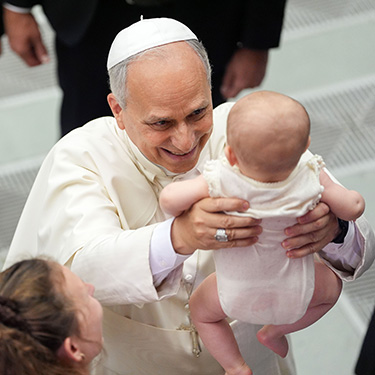
Naturally, Pope Leo said, Jesus “is troubled when faced with a path that seems to lead only to death and to the end. But he is equally persuaded that only a life lost for love, at the end, is ultimately found.”
“This is what true hope consists of: not in trying to avoid pain, but in believing that even in the heart of the most unjust suffering, the seed of new life is hidden,” he said.
After spending more than 90 minutes greeting people in the audience hall, including dozens of newlywed couples, Pope Leo went into St. Peter’s Basilica, where hundreds of people who did not get a place in the hall had been watching the audience and waiting for their turn to see the pope.
The pope thanked them for their patience, which, he said, “is a sign of the presence of the Spirit of God, who is with us. So often in life, we want to receive a response immediately, an immediate solution, and for some reason God makes us wait.”
“But as Jesus himself taught us, we must have that trust that comes from knowing that we are sons and daughters of God and that God always gives us grace,” the pope said. “He doesn’t always take away our pain or suffering, but he tells us that he is close to us.”
Faith’s family tree
Called To Holiness
By Jaymie Stuart Wolfe
Our Catholic faith doesn’t appear out of thin air, and it plays out incarnationally and across history. Faith comes from somewhere, and often, that somewhere is a someone, often visibly woven into our personal genealogies.
Everyone wants to claim some connection to our first American-born pope: Dolton, Illinois – the suburb just outside the southern limits of Chicago where the Prevost children grew up; Villanova University in Philadelphia where their youngest son went to college; St. Louis, where he entered the Augustinians; Chiclayo, Peru where Msgr. Prevost served as a missionary priest, and then bishop. Even Rome had a legitimate claim long before the name Robert Cardinal Prevost was announced from St. Peter’s loggia.
So, it comes as no surprise that there’s been a lot of Louisiana chatter about our new Holy Father’s Creole roots. The news of the pope’s ancestry flooded New Orleans news outlets within a few days of his election.
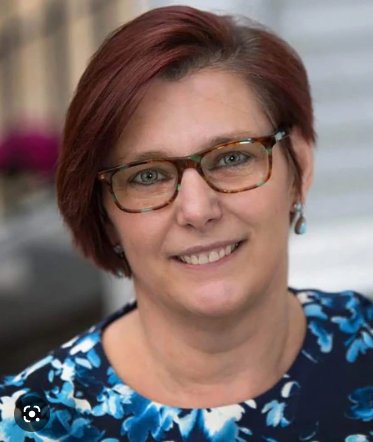
More recently, the story was published by the New York Times and Dr. Henry Louis Gates, Jr. presented a copy of the pope’s lineage to him at the Vatican.
But locally, a well-researched and fascinating exhibit showing Pope Leo’s maternal family tree has drawn many to the Old Ursuline Convent Museum in the French Quarter. There, visitors can explore seven generations of the Holy Father’s New Orleans ancestors, leading back to the years just after the city’s founding in 1718. Supported by sacramental records still held in the cathedral archives, the story Pope Leo’s family tree tells is a uniquely Catholic and American one.
The pope’s family includes immigrants from Bohemia, France, Italy, Cuba, Haiti, Guadeloupe and Canada. Also among his predecessors are numerous men and women identified as people of color – some free and others born enslaved.
It appears, in fact, that perhaps the only woman ever buried inside St. Louis Cathedral was one of the Holy Father’s forebears: a young woman of color who died in childbirth in 1799 and was interred near the Mary altar along with her baby. Family marriages and baptisms, too, can be found in New Orleans church records, some of which may have been thrown out of the windows during the famous Good Friday fire of 1788 by Père Antoine to save them.
In any case, what Pope Leo’s family tree reveals is the largely untold history of Black Catholics in colonies that eventually became part of the United States. This information, however, leaves us all with an unanticipated gift: the opportunity to recognize that the pope so many of us are excited about would not be who he is apart from the sad history of the African Diaspora caused by transatlantic slave trade and the complex racial history that followed in the wake of it.
If the Holy Father’s great-grandparents, Eugénie Grambois and Ferdinand Baquié, had not been baptized at the font in St. Louis Cathedral, (the only part of the church that survived the 1788 fire), chances are he would not have grown up Catholic. Nor would his maternal grandparents, the Martinez family, have likely chosen to make their home in Chicago without the Great Migration of 6 million people of color who left the American South for the promise of more economic opportunity and less racism at the beginning of the 20th century.
Our family histories vary widely. But all of us share a lineage of spiritual fathers and mothers whose words and deeds also make us what we are.
This summer, we observe the 1700th anniversary of the closing of the Council of Nicaea. Called by the unbaptized Emperor Constantine, the 318 bishops who gathered in Asia Minor defined what constituted Christian faith. Perhaps even more importantly, they determined what laid beyond the boundaries of orthodoxy. If they had not done so – or if the Arians had prevailed – the past 17 centuries would have been different.
The faith we profess today in the Nicene Creed remains the dividing line between what is Christian and what isn’t. Every ecumenical council since has influenced the course of history and added to the family tree of our faith.
Our task as Catholics is not only to recognize where we have come from, but to hand on what we have received. Most of us do that in the ordinary rhythms of family life, as the Holy Father’s ancestors did. Some of us, like the Fathers of Nicaea, embrace the mission by making choices that have an impact far greater and more universal than even they imagine.
(Jaymie Stuart Wolfe is a freelance writer and editor, speaker, and loves life in New Orleans.)
Hurricane Katrina 20th anniversary a call to racial equity, justice, say bishops
By Gina Christian
(OSV News) – The 20th anniversary of Hurricane Katrina marks a call to “renew our commitment to racial equity and justice in every sector of public life,” said two U.S. Catholic bishops.
Auxiliary Bishop Roy E. Campbell Jr. of Washington, chairman of the U.S. Conference of Catholic Bishops’ Subcommittee on African American Affairs, and retired Auxiliary Bishop Joseph N. Perry of Chicago, chairman of the USCCB’s Ad Hoc Committee Against Racism, issued a joint statement Aug. 26 reflecting on the tragedy.
The hurricane, one of the five deadliest in U.S. history, struck the nation’s Gulf Coast Aug. 29, 2005, as a Category 3 storm, with 120-140 mph winds and stretching 400 miles across the coast. At one point, the storm became a Category 5, but weakened before striking land.
Katrina made multiple landfalls, inflicting what the National Weather Service called “staggering” damage and loss of life, particularly in Louisiana and Mississippi. A total of 1,833 were killed by the storm, which at the time caused some $108 billion dollars in damage, according to NWS.
New Orleans was ravaged by the storm, with at least 80% of the city flooded by Aug. 31, 2005, NWS noted on its website, adding that the impact was “heightened by breaks in the levees that separate New Orleans from Lake Pontchartrain.”
Compounding the damage were key failures in governmental response, and in their statement, Bishop Campbell and Bishop Perry said that “despite the scale of devastation, it took days before the federal government responded with aid.”
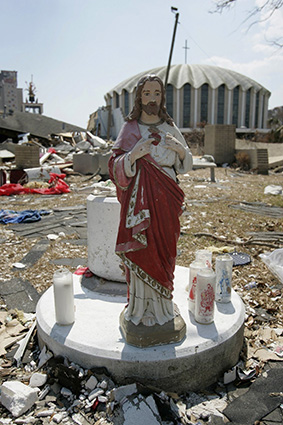
More broadly, they observed, Hurricane Katrina “threw into stark focus the deep racial and socio-economic disparities across various sectors, including environmental justice, systemic housing inequality, and disaster response.”
The bishops pointed out that “some of the most catastrophic damage occurred in neighborhoods like the Ninth Ward, a predominantly Black neighborhood, which was under so much water that many of the residents had to take refuge in their attics and on their rooftops to avoid the rising tides.
“Today, we pray with those who still suffer from the loss of family and friends and whose very identities were affected,” said the bishops.
They also noted that the storm resulted in “the loss of irreplaceable items handed down through generations such as photos, videos, diaries, genealogical records, documents, and other mementos that are an essential means of sharing a person’s existence, history, and culture.”
In addition, said the bishops, “many residents were unable to return home because gentrification caused their former neighborhoods to become unaffordable.
“Disparities, rooted in historical and structural racism, intensified the suffering of many Black residents,” they said.
The hurricane and the response missteps “revealed the fragility of our cities to natural disasters and the reality of poverty among the most vulnerable in our country,” the bishops noted.
Bishop Campbell and Bishop Perry extolled the “powerful witness of the Catholic Church” that countered the “inadequate governmental response” to Katrina, citing the work of Catholic Charities USA and its local agencies, the USCCB’s Catholic Campaign for Human Development and Catholic Home Missions Appeal, the Archdiocese of New Orleans and the Knights of Columbus.
The two bishops stressed the “dire need for equitable investments in climate resilience and preparedness,” amid storms intensified by climate change.
“Katrina revealed how quickly entire communities can be overlooked, their cultures erased as neighborhoods vanished – taking with it cherished cultural spaces and historic landmarks,” said Bishop Campbell and Bishop Perry.
They added that two decades later, “many still struggle to rebuild intangible bonds,” with “ongoing mental and physical injuries” still evident today, while the “gap between the wealthy and poor continues to grow.”
Concluding their statement, Bishop Campbell and Bishop Perry said, “Let us join together, as one community, responding to the call to be leaven for the world. As church, let us be a lifeboat in the flood waters of injustice.”
Minneapolis pastor recalls heroism amid tragedy at school Mass shooting
By Joe Ruff and Josh McGovern
MINNEAPOLIS (OSV News) – For the first time since the Aug. 27 attack by a shooter who killed two children and wounded at least 21 more victims at an all-school Mass where he was presiding at Annunciation Catholic Church, Father Dennis Zehren publicly described his attempt to save the children.
“If I could have got between those bullets and the kids,” Father Zehren said, his voice breaking with emotion at an Aug. 30 news conference outside Annunciation elementary school.
“That’s what I was hoping to do. … the doors were barred, shut on the outside by the gunman,” said Father Zehren, Annunciation’s pastor. “We tried to get out. I think some of the fathers would have gone out there and gang-rushed him if they could have, and I would have been right there with them.
“But I think by that time, the damage was done,” and the shooter died of a self-inflicted gunshot wound, Father Zehren said.
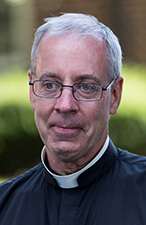
“It’s a difficult memory,” Father Zehren said. “It just was loud (the gunshots). It just kept coming, and my first instinct was to just rush toward where the bullets were coming from. There were some fathers who were heading in the same direction, and I was on the phone with 911 just hoping to peek out the window to see which direction (the shooter) might be going in. So I could give them some help. But it was a flurry, and like I said, it seemed to keep coming.”
The news conference took place before the first parish Mass – held at the Annunciation Catholic School’s auditorium instead of the now-desecrated church – since the shooting. The school is steps away from the church.
Identified as Robin Westman, the suspected shooter was a former Annunciation student, then known as Robert Westman, whose mother had been previously employed by the school. Westman fired from three guns through Annunciation’s stained-glass windows around 8:30 a.m. during the first all-school Mass of the PreK-to-eighth-grade school’s academic year. Westman died by suicide in the parking lot.
Archbishop Bernard A. Hebda of St. Paul and Minneapolis joined Father Zehren at the news conference, at one point placing his hand on the priest’s shoulder in support. The archbishop concelebrated the Mass that followed.
The archbishop and Father Zehren opened the news conference describing the importance of the Mass to the Catholic faith. The fact that Annunciation parish would hold a public Mass so soon after the church shooting might surprise some, the archbishop said.
“And yet it’s so important for us in our Catholic tradition for Masses, where we most experience God’s presence and God’s love,” Archbishop Hebda said. “And it’s the place where we come together to be a community.”
Father Zehren said the Mass is what the parish community needs.
“This is why we’re here,” he said. “They just want to be together. They want to pray. They want to help and do anything they can.
“Mass is the heart of what we do,” Father Zehren said. “The Mass is not just a worship service. Because we recognize that as Catholics … we enter into the paschal mystery of Jesus.”
That mystery is presented to the community each time a Mass is celebrated, the priest said.
“Whenever we gather at Mass, we are re-presented with Jesus … at the Last Supper. We are presented with his suffering … with his dying, and … with his rising from the dead,” Father Zehren said.
Asked about the impact of the church attack occurring during a Mass, Father Zehren said he would be “reflecting on that for the rest of my life.”
“I will never be able to unsee,” Father Zehren said. “But in addition to the sorrow and the terror, we know that Jesus was there with us. … Jesus comes to the depths of what we are going through. That’s where he brings the healing and the salvation for whatever we go through.”
Attending the Mass with his family was Sean O’Brien, an Annunciation alumnus and parent who said he was at the Aug. 27 Mass in the back of the church with his 2-year-old daughter, Molly, when shots rang out. His son Emmett, an Annunciation preschooler, was in the basement. His other children, fourth-grader Conor and first-grader Finley, were sitting with their classmates.
“I saw a shaft of light going through the window and that’s when I knew we were being attacked,” O’Brien said.
“I grabbed my daughter, and we went behind a pillar. … When the shooting stopped, we said, ‘OK, who needs help?’ And we did what we could.’”
O’Brien, 37, said he rushed to an injured student and remained there until the police came.
“There were people taking action that were motivated by the love they felt for the people around them, from the very moment things started,” he said. “And that’s only going to continue and get stronger.”
Sean’s wife, Mallory, said she learned that Finley was with her eighth-grade buddy, in a school tradition where older students accompany younger students to school Masses.
“They held hands all the way to the school” as students were evacuated, Mallory O’Brien said.
The O’Briens expressed gratitude that no one in their family was injured. And with service and community in mind, they are helping others where they can.
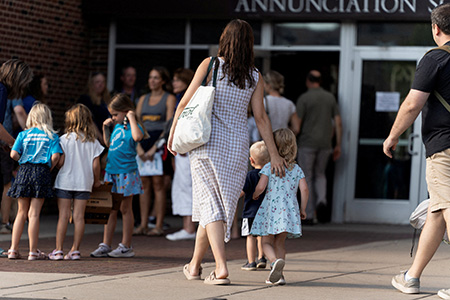
“We’ve really been getting together all week ever since Wednesday (Aug. 27),” Sean O’Brien said after the Mass. “The best thing for us has been to be together with the people that we love in this parish and in this community. … To be here, to be together again, really means a lot. There’s no place we’d rather be.”
At Mass in the school’s auditorium the following day, Father Zehren talked about the immense help parishioners and neighbors, community responders and others have provided one another. He compared it to the book of Exodus passage in which Moses lifted his arms and hands in prayer, and when he wearied, the Israelites fell back in battle. When Moses held up his arms, they prospered in the fight.
“That’s what we’ve been experiencing in so many ways around here. All of you. All of our neighbors, all of our community, police, first responders, they’ve been a rock underneath us,” he said Aug. 31. “And they will continue to be a rock for us. There (are) so many people who will be continuing to hold up our hands in prayer.”
(Joe Ruff is editor-in-chief and Josh McGovern is a reporter for The Catholic Spirit, the newspaper of the Archdiocese of St. Paul and Minneapolis.)
Annunciation Church to be reconsecrated before Mass there resumes
By Maria Wiering
ST. PAUL (OSV News) – Annunciation Catholic Church in Minneapolis will be reconsecrated before it again holds Mass after an Aug. 27 shooting during a Mass for schoolchildren left two children dead and 18 other victims wounded.
“The church does make provision” for reconsecrating a church building after a desecration, Archbishop Bernard A. Hebda told OSV News Aug. 28. “I’ve never had to do that, but I think it will be an important time. Here, where the church is still a crime scene and where there’s been substantial destruction, I think it’s probably going to be a while before we’re able to do that.”
While there are other places on the campus of Annunciation Catholic Church and Annunciation Catholic School that could hold Mass in the interim, “my understanding is that the church’s tradition is that no Mass or sacrament would be celebrated in there until there is that rite of reconsecration,” Archbishop Hebda said.
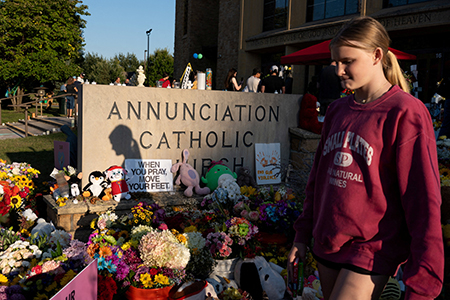
Canon No. 1211 in the church’s law states, “Sacred places are violated by gravely injurious actions done in them with scandal to the faithful, actions which, in the judgment of the local ordinary, are so grave and contrary to the holiness of the place that it is not permitted to carry on worship in them until the damage is repaired by a penitential rite according to the norm of the liturgical books.”
“I’m grateful that I will have that privilege of doing that at some point,” Archbishop Hebda said, speaking at the archdiocesan headquarters in St. Paul. “The church has such wisdom even about human nature and the human person, and even to have a ritual that would help people in that time of need, I think, is very significant.
“You hope that it will be an opportunity, whenever that occurs, for some healing,” he added, noting that he will work with Annunciation’s pastor, Father Dennis Zehren, on appropriate timing for the ritual. “It would be a priority for me, as I know it is for him.”
A former student at the school whose mother also previously worked there, the shooter, identified as Robin Westman, fired from three guns through Annunciation’s stained-glass windows around 8:30 a.m. during Annunciation Catholic School’s first all-school Mass of the PreK-to-eighth-grade school’s academic year. Westman died by suicide in the parking lot.
Investigators are working through a hate-riddled online manifesto posted by the shooter and other evidence to determine a clear motive for the violence and why Annunciation was targeted.
Fletcher Merkel, 8, and Harper Moyski, 10, were killed in their pews. Other victims, including 15 children and three adults in their 80s, were taken to nearby hospitals, including Hennepin County Medical Center, a Level 1 trauma center.
An extensive, spontaneous memorial of flowers, gifts and messages outside of the church includes tributes to Merkel and Moyski, as well as prayers for those injured and the school’s families.
Archbishop Hebda visited the school Aug. 27 and has since presided at several prayer services for the victims and the mourning community.
Annunciation Catholic Church was founded in 1922. Its parish school was founded by Dominican sisters the following year. The present church building was completed in 1962.
Fletcher loved his family, Harper was a ‘joyful’ big sister: Annunciation victims mourned
(OSV News) – Eight-year-old Fletcher Merkel “loved his family, friends, fishing, cooking and any sport that he was allowed to play.” Ten-year-old Harper Moyski was a “joyful” big sister, who was “bright” and “deeply loved.”
The parents of both children confirmed as victims of the Aug. 27 shooting at Annunciation Catholic Church issued their first statements in the aftermath, mourning the loss of their children.
Jesse Merkel, Fletcher’s father, said the hole left in his family’s hearts by his son’s death will never be filled, during an Aug. 28 press conference outside Annunciation School in Minneapolis.
In his remarks, Jesse Merkel said they would never be allowed to “watch him grow into the wonderful young man he was on the path to becoming.”
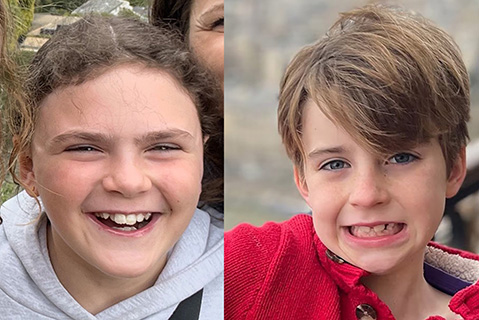
He also noted prayers for the family of Harper Moyski and of the other people affected by the shooting, and expressed gratitude for “the swift and heroic actions of children and adults alike” inside the church.
“We ask not for your sympathy, but your empathy as our family and our Annunciation community grieve and try to make sense of such a senseless act of violence,” Merkel said. “Please remember Fletcher for the person he was, and not the act that ended his life.”
Harper was a “bright, joyful, and deeply loved 10-year-old whose laughter, kindness, and spirit touched everyone,” her parents, Michael Moyski and Jackie Flavin, said in a statement issued Aug. 28.
“Our hearts are broken not only as parents, but also for Harper’s sister, who adored her big sister and is grieving an unimaginable loss. As a family, we are shattered,” they said.
“While our immediate focus is on Harper and our family’s healing, we also believe it is important that her memory fuels action. No family should ever have to endure this kind of pain. We urge our leaders and communities to take meaningful steps to address gun violence and the mental health crisis in this country,” they continued.
“Harper’s light will always shine through us, and we hope her memory inspires others to work toward a safer, more compassionate world.”
Choking back tears, Fletcher’s father pleaded: “Give your kids an extra hug and kiss today.”
He said, “We love you, Fletcher, and you’ll always be with us.”
